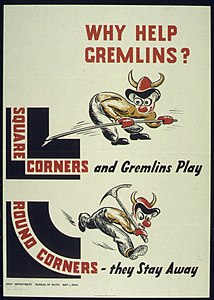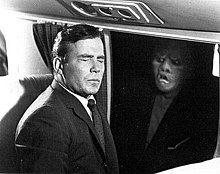
Roald Dahl was a British author of popular children's literature and short stories, a poet, screenwriter and a wartime fighter ace. His books have sold more than 300 million copies worldwide. Dahl has been called "one of the greatest storytellers for children of the 20th century".
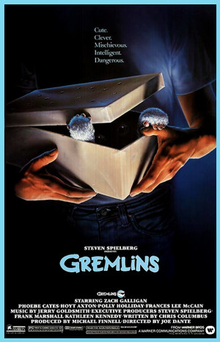
Gremlins is a 1984 American comedy horror film directed by Joe Dante, written by Chris Columbus, and starring Zach Galligan, Phoebe Cates, Hoyt Axton, Polly Holliday, and Frances Lee McCain, with Howie Mandel providing the voice of Gizmo, the main mogwai character. It draws on legends of folkloric mischievous creatures that cause malfunctions—"gremlins"—in the British Royal Air Force going back to World War II. The story follows young man Billy Peltzer, who receives a strange creature as a pet, which then spawns other creatures that transform into aggressive, imp-like monsters that wreak havoc on Billy's town during Christmas Eve.
Flibbertigibbet is a Middle English word referring to a flighty or whimsical person, usually a young woman. In modern use, it is used as a slang term, especially in Yorkshire, for a gossipy or overly talkative person.
Wing commander is a senior officer rank used by some air forces, with origins from the Royal Air Force. The rank is used by air forces of many countries that have historical British influence. Equivalent to Colonel in other services.
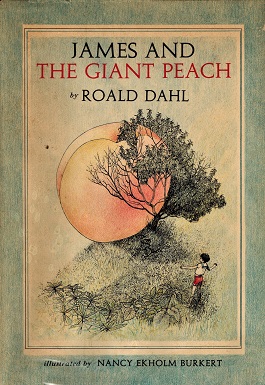
James and the Giant Peach is a popular children's novel written in 1961 by British author Roald Dahl. The first edition, published by Alfred Knopf, featured illustrations by Nancy Ekholm Burkert. There have been re-illustrated versions of it over the years, done by Michael Simeon, Emma Chichester Clark, Lane Smith and Quentin Blake. It was adapted into a film of the same name in 1996 which was directed by Henry Selick, and a musical in 2010.

"Nightmare at 20,000 Feet" is the third episode of the fifth season American television anthology series The Twilight Zone, based on the short story of the same name by Richard Matheson, first published in the short story anthology Alone by Night (1961). It originally aired on October 11, 1963, and is one of the most well-known and frequently referenced episodes of the series. The story follows a passenger on an airline flight who notices a hideous creature trying to sabotage the aircraft during flight.

Falling Hare is a 1943 Warner Bros. Merrie Melodies cartoon directed by Bob Clampett. The cartoon features Bugs Bunny.

The Women Airforce Service Pilots (WASP) was a civilian women pilots' organization, whose members were United States federal civil service employees. Members of WASP became trained pilots who tested aircraft, ferried aircraft and trained other pilots. Their purpose was to free male pilots for combat roles during World War II. Despite various members of the armed forces being involved in the creation of the program, the WASP and its members had no military standing.
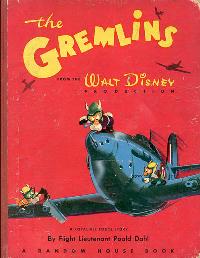
The Gremlins is a children's book written by British author Roald Dahl and published in 1943. In writing the book, Dahl draws on his own experience as a Royal Air Force (RAF) pilot during the Second World War. The story's principal character Gus, an RAF pilot, has his Hawker Hurricane destroyed over the English Channel by a gremlin—mischievous creatures who were part of RAF folklore. As they parachute into the water, Gus convinces the gremlins to join forces against a common enemy; Hitler and the Nazis. It was Dahl's first book and was written for Walt Disney Productions, in anticipation of a feature-length animated film that was never made.

The Martin 187 Baltimore was a twin-engined light attack bomber built by the Glenn L. Martin Company in the United States as the A-30. The model was originally ordered by the French in May 1940 as a follow-up to the earlier Martin Maryland, then in service in France. With the fall of France, the production series was diverted to Great Britain and after mid-1941, supplied by the U.S. as Lend Lease equipment.

Fifinella was a female gremlin designed by Walt Disney for a proposed film from Roald Dahl's book The Gremlins. During World War II, the Women Airforce Service Pilots (WASP) asked permission to use the image as their official mascot, and the Disney Company granted them the rights.

Russian Rhapsody is a 1944 Warner Bros. Merrie Melodies cartoon directed by Bob Clampett. The short was released on May 20, 1944.

Some Time Never: A Fable for Supermen is a 1948 book by Roald Dahl, his first adult novel. Dahl began writing it after editor Maxwell Perkins expressed an interest in publishing a novel length book if Dahl were to write it. The book was met with predominantly poor reception and was considered to be a failure, although it is historically noteworthy as one of the first novels about nuclear war to be published after the atomic bombings of Hiroshima and Nagasaki. The story is a darker take on the same premise as Dahl's first children's novel, The Gremlins.
The third wave of Walt Disney Treasures was released on May 18, 2004. It was originally planned to be released in December 2003, but was delayed for almost half a year in order to meet an increased demand with a higher number of tins produced. This wave was the first to have a certificate of authenticity with the individual number of the tin on it, replacing the number embossed on the tin. This was the final wave released with side straps.
Fifinella (1913–1931) was a British Thoroughbred racehorse and broodmare. In a career that lasted from 1915 until 1917 she ran seven times and won four races. She was the highest-rated British two-year-old of either sex in 1915 and went on to greater success the following season. As a three-year-old in 1916 she won the Derby and Oaks both of which were run that year at Newmarket. She was the sixth and most recent filly to win the Derby.
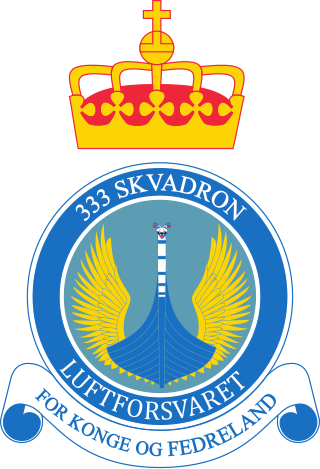
333 Squadron of the Royal Norwegian Air Force is a maritime patrol aircraft squadron. It traces its history, unbroken, to the establishment of No. 333 (Norwegian) Squadron Royal Air Force of the Second World War, formed in February 1942.

Royal Air Force Sutton Bridge or more simply RAF Sutton Bridge is a former Royal Air Force station found next to the village of Sutton Bridge in the south-east of Lincolnshire. The airfield was to the south of the current A17, and east of the River Nene, next to Walpole in Norfolk.
The Battle of Athens on 20 April 1941 is the name given by author Roald Dahl to a dog-fighting air battle over Athens fought for half an hour between the Royal Air Force and the Luftwaffe towards the end of the Battle of Greece.

Roald Dahl (1916–1990) was a British author and scriptwriter, and "the most popular writer of children's books since Enid Blyton", according to Philip Howard, the literary editor of The Times. He was raised by his Norwegian mother, who took him on annual trips to Norway, where she told him the stories of trolls and witches present in the dark Scandinavian fables. Dahl was influenced by the stories, and returned to many of the themes in his children's books. His mother also nurtured a passion in the young Dahl for reading and literature.
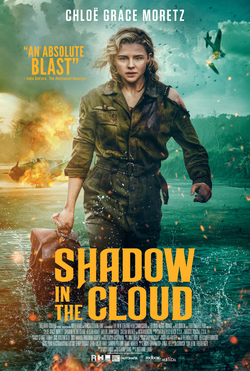
Shadow in the Cloud is a 2020 action horror film directed by Roseanne Liang, from a screenplay by Liang and Max Landis, starring Chloë Grace Moretz, Beulah Koale, Taylor John Smith, Callan Mulvey and Nick Robinson. It follows a female flight officer on a top-secret mission in the Pacific during the Second World War, who after boarding a Boeing B-17 Flying Fortress, encounters an evil gremlin during the flight.






